Report on Thalassemia: A Method Critique of Long-Term Health Impacts
VerifiedAdded on 2023/06/16
|9
|2307
|391
Report
AI Summary
This report presents a method critique focused on the long-term impacts of Thalassemia, an inherited blood disorder characterized by reduced hemoglobin levels. The study explores the causes of Thalassemia, including genetic mutations affecting hemoglobin production, and discusses its effects on growth, bone health, spleen function, and overall well-being. It examines various treatments, such as blood transfusions and chelation therapy, while also acknowledging their potential side effects. The report employs a qualitative research approach, analyzing secondary data to understand the complexities of Thalassemia and its management. It concludes that while treatments can mitigate some effects, severe cases often pose significant challenges, emphasizing the importance of early diagnosis and comprehensive care. Desklib provides access to this and other solved assignments for students.

Method Critique on Thalassemia
1
1
Paraphrase This Document
Need a fresh take? Get an instant paraphrase of this document with our AI Paraphraser

Table of Contents
TITLE: TO DISCUSS LONG TERM IMPACTS OF THALASSEMIA.......................................3
INTRODUCTION...........................................................................................................................3
BACKGROUND.............................................................................................................................3
Aim and objectives......................................................................................................................3
LITERATURE REVIEW................................................................................................................3
Causing factors of Thalassemia...................................................................................................3
Impacts of Thalassemia on people’s growth...............................................................................4
Best treatment for Thalassemia...................................................................................................4
METHODOLOGY..........................................................................................................................5
RESULTS........................................................................................................................................6
Reasons of Thalassemia...............................................................................................................6
Long term and severe impacts of Thalassemia............................................................................6
Interventions for protecting people from anaemia or Thalassemia.............................................7
DISCUSSION..................................................................................................................................7
CONCLUSION................................................................................................................................8
REFERENCES................................................................................................................................9
2
TITLE: TO DISCUSS LONG TERM IMPACTS OF THALASSEMIA.......................................3
INTRODUCTION...........................................................................................................................3
BACKGROUND.............................................................................................................................3
Aim and objectives......................................................................................................................3
LITERATURE REVIEW................................................................................................................3
Causing factors of Thalassemia...................................................................................................3
Impacts of Thalassemia on people’s growth...............................................................................4
Best treatment for Thalassemia...................................................................................................4
METHODOLOGY..........................................................................................................................5
RESULTS........................................................................................................................................6
Reasons of Thalassemia...............................................................................................................6
Long term and severe impacts of Thalassemia............................................................................6
Interventions for protecting people from anaemia or Thalassemia.............................................7
DISCUSSION..................................................................................................................................7
CONCLUSION................................................................................................................................8
REFERENCES................................................................................................................................9
2

TITLE: TO DISCUSS LONG TERM IMPACTS OF THALASSEMIA.
INTRODUCTION
In regard to Thalassemia, it can be said that it is inherited blood disorder that causes
people’s body to have less hemoglobin than average (Thompson and et.al., 2018). Human body
needs 12.0-17.5 per decilitre haemoglobin otherwise as it enables red blood cells to carry out
oxygen that is essential for surviving. Less haemoglobin causes problems of anaemia that is
known as deficiency of red blood cells.
BACKGROUND
This study is going to discuss some main causes of Thalassemia along with treatment that
can be given to people who are suffering from severe Thalassemia. It will further discuss long
term impacts that Thalassemia can have on people. Research methodology also plays a vital role
in accomplishing research aim as it enables researchers in gathering appropriate data. Primary
and secondary data collection both helps researcher in knowing all about research topic and this
study will discuss better ways of analysing secondary data.
Aim and objectives
Aim: The main aim of conducting this research is “To identify long term impacts that
Thalassemia can have on people”.
Objectives
To identify causing factors of Thalassemia.
To discuss impacts of Thalassemia on people’s growth.
To identify best treatment for Thalassemia.
LITERATURE REVIEW
Causing factors of Thalassemia
According to the Fibach and Rachmilewitz, (2017) Thalassemia caused by mutation in the
DNA of cells that make haemoglobin. Thalassemia is all about anaemia or loss of blood that
happens when number of red blood cells in body decreased. Tari and et.al., (2018) stated that
there is a substance in red blood cells that carries out oxygen throughout human’s body.
3
INTRODUCTION
In regard to Thalassemia, it can be said that it is inherited blood disorder that causes
people’s body to have less hemoglobin than average (Thompson and et.al., 2018). Human body
needs 12.0-17.5 per decilitre haemoglobin otherwise as it enables red blood cells to carry out
oxygen that is essential for surviving. Less haemoglobin causes problems of anaemia that is
known as deficiency of red blood cells.
BACKGROUND
This study is going to discuss some main causes of Thalassemia along with treatment that
can be given to people who are suffering from severe Thalassemia. It will further discuss long
term impacts that Thalassemia can have on people. Research methodology also plays a vital role
in accomplishing research aim as it enables researchers in gathering appropriate data. Primary
and secondary data collection both helps researcher in knowing all about research topic and this
study will discuss better ways of analysing secondary data.
Aim and objectives
Aim: The main aim of conducting this research is “To identify long term impacts that
Thalassemia can have on people”.
Objectives
To identify causing factors of Thalassemia.
To discuss impacts of Thalassemia on people’s growth.
To identify best treatment for Thalassemia.
LITERATURE REVIEW
Causing factors of Thalassemia
According to the Fibach and Rachmilewitz, (2017) Thalassemia caused by mutation in the
DNA of cells that make haemoglobin. Thalassemia is all about anaemia or loss of blood that
happens when number of red blood cells in body decreased. Tari and et.al., (2018) stated that
there is a substance in red blood cells that carries out oxygen throughout human’s body.
3
⊘ This is a preview!⊘
Do you want full access?
Subscribe today to unlock all pages.

Trusted by 1+ million students worldwide
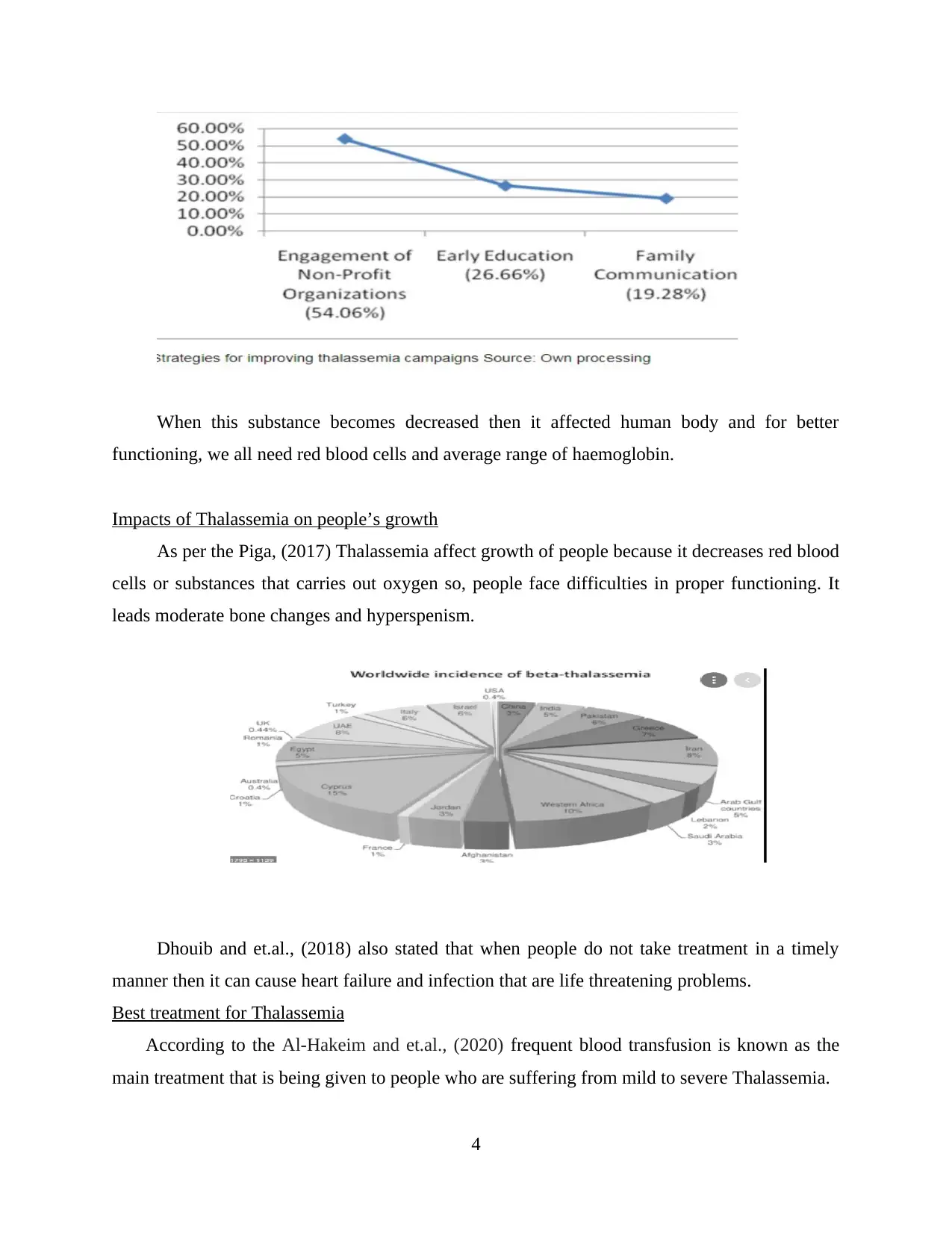
When this substance becomes decreased then it affected human body and for better
functioning, we all need red blood cells and average range of haemoglobin.
Impacts of Thalassemia on people’s growth
As per the Piga, (2017) Thalassemia affect growth of people because it decreases red blood
cells or substances that carries out oxygen so, people face difficulties in proper functioning. It
leads moderate bone changes and hyperspenism.
Dhouib and et.al., (2018) also stated that when people do not take treatment in a timely
manner then it can cause heart failure and infection that are life threatening problems.
Best treatment for Thalassemia
According to the Al-Hakeim and et.al., (2020) frequent blood transfusion is known as the
main treatment that is being given to people who are suffering from mild to severe Thalassemia.
4
functioning, we all need red blood cells and average range of haemoglobin.
Impacts of Thalassemia on people’s growth
As per the Piga, (2017) Thalassemia affect growth of people because it decreases red blood
cells or substances that carries out oxygen so, people face difficulties in proper functioning. It
leads moderate bone changes and hyperspenism.
Dhouib and et.al., (2018) also stated that when people do not take treatment in a timely
manner then it can cause heart failure and infection that are life threatening problems.
Best treatment for Thalassemia
According to the Al-Hakeim and et.al., (2020) frequent blood transfusion is known as the
main treatment that is being given to people who are suffering from mild to severe Thalassemia.
4
Paraphrase This Document
Need a fresh take? Get an instant paraphrase of this document with our AI Paraphraser
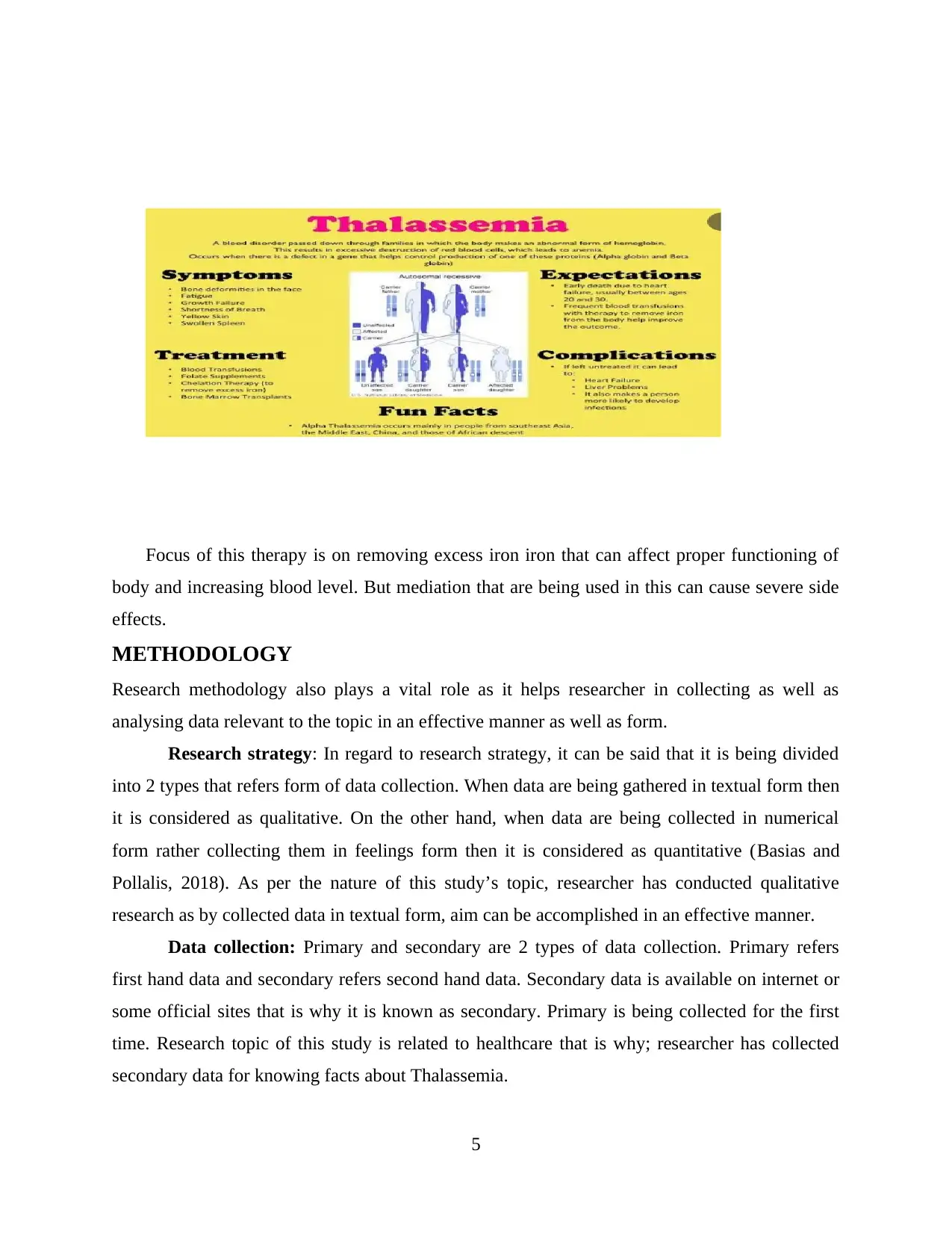
Focus of this therapy is on removing excess iron iron that can affect proper functioning of
body and increasing blood level. But mediation that are being used in this can cause severe side
effects.
METHODOLOGY
Research methodology also plays a vital role as it helps researcher in collecting as well as
analysing data relevant to the topic in an effective manner as well as form.
Research strategy: In regard to research strategy, it can be said that it is being divided
into 2 types that refers form of data collection. When data are being gathered in textual form then
it is considered as qualitative. On the other hand, when data are being collected in numerical
form rather collecting them in feelings form then it is considered as quantitative (Basias and
Pollalis, 2018). As per the nature of this study’s topic, researcher has conducted qualitative
research as by collected data in textual form, aim can be accomplished in an effective manner.
Data collection: Primary and secondary are 2 types of data collection. Primary refers
first hand data and secondary refers second hand data. Secondary data is available on internet or
some official sites that is why it is known as secondary. Primary is being collected for the first
time. Research topic of this study is related to healthcare that is why; researcher has collected
secondary data for knowing facts about Thalassemia.
5
body and increasing blood level. But mediation that are being used in this can cause severe side
effects.
METHODOLOGY
Research methodology also plays a vital role as it helps researcher in collecting as well as
analysing data relevant to the topic in an effective manner as well as form.
Research strategy: In regard to research strategy, it can be said that it is being divided
into 2 types that refers form of data collection. When data are being gathered in textual form then
it is considered as qualitative. On the other hand, when data are being collected in numerical
form rather collecting them in feelings form then it is considered as quantitative (Basias and
Pollalis, 2018). As per the nature of this study’s topic, researcher has conducted qualitative
research as by collected data in textual form, aim can be accomplished in an effective manner.
Data collection: Primary and secondary are 2 types of data collection. Primary refers
first hand data and secondary refers second hand data. Secondary data is available on internet or
some official sites that is why it is known as secondary. Primary is being collected for the first
time. Research topic of this study is related to healthcare that is why; researcher has collected
secondary data for knowing facts about Thalassemia.
5

Data analysis: For analysing qualitative and secondary data, researcher has selected
qualitative data analysis tool (Watkins, 2017). If researcher has conducted quantitative then he
would have selected quantitative data analysis tool. By thematic analysis, gathered data have
been analysed.
RESULTS
Reasons of Thalassemia
Thalassemia is diseases that mostly passed from parents to children because it is caused by
mutations in DNA of cells that play role for making haemoglobin (Hasanshahi and Khanjani,
2021). Haemoglobin molecules that are being made from alpha and beta, affected by mutations
and it is the reason as people face problems with decreasing rate of red blood cells and anaemia.
When alpha and beta chains are decreased in production then it causes alpha Thalassemia and
beta Thalassemia. Severity of alpha and beta Thalassemia depends on the number of gene
mutations that children inherited from their parents. If children have more mutated gene then
they are more likely to suffer from severe Thalassemia. Whereas, in beta type of Thalassemia,
severity of this problem relies on the part of haemoglobin molecules that got affected (Ebeid and
Khan, 2020).
Long term and severe impacts of Thalassemia
Thalassemia has number of negative impacts such as: bone deformities, enlarged spleen,
slowed growth rates and infection. One of the main long term severe impacts of this disease is:
widen bones as Thalassemia makes bone marrow expand that cause this problem (Kountouris
and et.al., 2021). It leads abnormal bone structure especially on face and skull. Bone marrow
cause number of problems as it makes bones of affected people thin that increase chances of
broken bones. Other main impact that mild to severe Thalassemia has on children and adults is
enlarged spleen. In regard to spleen, it can be said that it helps human’s body in fighting against
infection as well as filtering unwanted materials like old cells. Thalassemia enlarges spleen and
body find difficulties in functioning their work of filtering unwanted materials (Betts and et.al.,
2020). When it is enlarged then people’s body become unable to fight against infections and they
become more prominent for infectious disease. Heart disease and slowed growth rate are other
main impacts of Thalassemia.
6
qualitative data analysis tool (Watkins, 2017). If researcher has conducted quantitative then he
would have selected quantitative data analysis tool. By thematic analysis, gathered data have
been analysed.
RESULTS
Reasons of Thalassemia
Thalassemia is diseases that mostly passed from parents to children because it is caused by
mutations in DNA of cells that play role for making haemoglobin (Hasanshahi and Khanjani,
2021). Haemoglobin molecules that are being made from alpha and beta, affected by mutations
and it is the reason as people face problems with decreasing rate of red blood cells and anaemia.
When alpha and beta chains are decreased in production then it causes alpha Thalassemia and
beta Thalassemia. Severity of alpha and beta Thalassemia depends on the number of gene
mutations that children inherited from their parents. If children have more mutated gene then
they are more likely to suffer from severe Thalassemia. Whereas, in beta type of Thalassemia,
severity of this problem relies on the part of haemoglobin molecules that got affected (Ebeid and
Khan, 2020).
Long term and severe impacts of Thalassemia
Thalassemia has number of negative impacts such as: bone deformities, enlarged spleen,
slowed growth rates and infection. One of the main long term severe impacts of this disease is:
widen bones as Thalassemia makes bone marrow expand that cause this problem (Kountouris
and et.al., 2021). It leads abnormal bone structure especially on face and skull. Bone marrow
cause number of problems as it makes bones of affected people thin that increase chances of
broken bones. Other main impact that mild to severe Thalassemia has on children and adults is
enlarged spleen. In regard to spleen, it can be said that it helps human’s body in fighting against
infection as well as filtering unwanted materials like old cells. Thalassemia enlarges spleen and
body find difficulties in functioning their work of filtering unwanted materials (Betts and et.al.,
2020). When it is enlarged then people’s body become unable to fight against infections and they
become more prominent for infectious disease. Heart disease and slowed growth rate are other
main impacts of Thalassemia.
6
⊘ This is a preview!⊘
Do you want full access?
Subscribe today to unlock all pages.

Trusted by 1+ million students worldwide
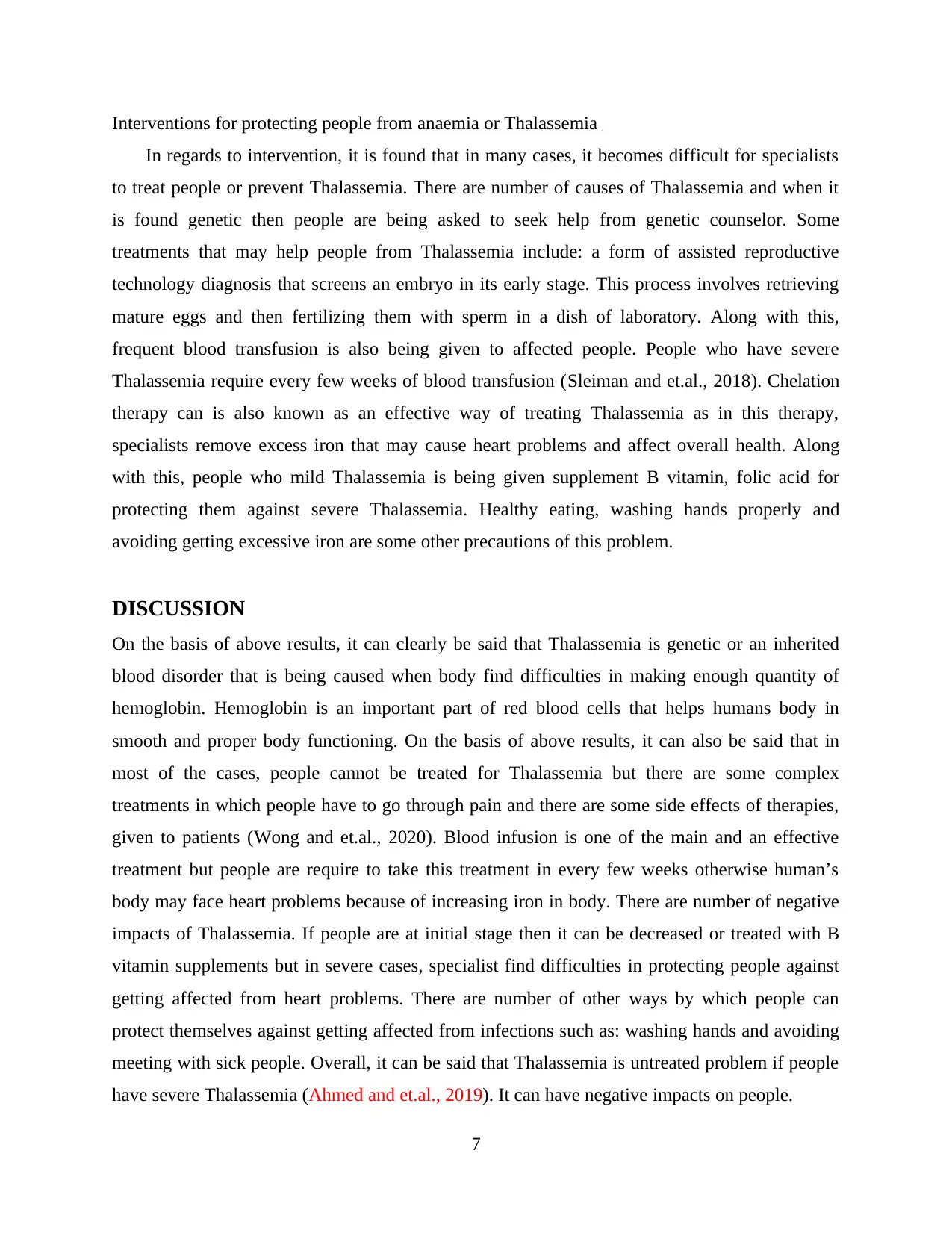
Interventions for protecting people from anaemia or Thalassemia
In regards to intervention, it is found that in many cases, it becomes difficult for specialists
to treat people or prevent Thalassemia. There are number of causes of Thalassemia and when it
is found genetic then people are being asked to seek help from genetic counselor. Some
treatments that may help people from Thalassemia include: a form of assisted reproductive
technology diagnosis that screens an embryo in its early stage. This process involves retrieving
mature eggs and then fertilizing them with sperm in a dish of laboratory. Along with this,
frequent blood transfusion is also being given to affected people. People who have severe
Thalassemia require every few weeks of blood transfusion (Sleiman and et.al., 2018). Chelation
therapy can is also known as an effective way of treating Thalassemia as in this therapy,
specialists remove excess iron that may cause heart problems and affect overall health. Along
with this, people who mild Thalassemia is being given supplement B vitamin, folic acid for
protecting them against severe Thalassemia. Healthy eating, washing hands properly and
avoiding getting excessive iron are some other precautions of this problem.
DISCUSSION
On the basis of above results, it can clearly be said that Thalassemia is genetic or an inherited
blood disorder that is being caused when body find difficulties in making enough quantity of
hemoglobin. Hemoglobin is an important part of red blood cells that helps humans body in
smooth and proper body functioning. On the basis of above results, it can also be said that in
most of the cases, people cannot be treated for Thalassemia but there are some complex
treatments in which people have to go through pain and there are some side effects of therapies,
given to patients (Wong and et.al., 2020). Blood infusion is one of the main and an effective
treatment but people are require to take this treatment in every few weeks otherwise human’s
body may face heart problems because of increasing iron in body. There are number of negative
impacts of Thalassemia. If people are at initial stage then it can be decreased or treated with B
vitamin supplements but in severe cases, specialist find difficulties in protecting people against
getting affected from heart problems. There are number of other ways by which people can
protect themselves against getting affected from infections such as: washing hands and avoiding
meeting with sick people. Overall, it can be said that Thalassemia is untreated problem if people
have severe Thalassemia (Ahmed and et.al., 2019). It can have negative impacts on people.
7
In regards to intervention, it is found that in many cases, it becomes difficult for specialists
to treat people or prevent Thalassemia. There are number of causes of Thalassemia and when it
is found genetic then people are being asked to seek help from genetic counselor. Some
treatments that may help people from Thalassemia include: a form of assisted reproductive
technology diagnosis that screens an embryo in its early stage. This process involves retrieving
mature eggs and then fertilizing them with sperm in a dish of laboratory. Along with this,
frequent blood transfusion is also being given to affected people. People who have severe
Thalassemia require every few weeks of blood transfusion (Sleiman and et.al., 2018). Chelation
therapy can is also known as an effective way of treating Thalassemia as in this therapy,
specialists remove excess iron that may cause heart problems and affect overall health. Along
with this, people who mild Thalassemia is being given supplement B vitamin, folic acid for
protecting them against severe Thalassemia. Healthy eating, washing hands properly and
avoiding getting excessive iron are some other precautions of this problem.
DISCUSSION
On the basis of above results, it can clearly be said that Thalassemia is genetic or an inherited
blood disorder that is being caused when body find difficulties in making enough quantity of
hemoglobin. Hemoglobin is an important part of red blood cells that helps humans body in
smooth and proper body functioning. On the basis of above results, it can also be said that in
most of the cases, people cannot be treated for Thalassemia but there are some complex
treatments in which people have to go through pain and there are some side effects of therapies,
given to patients (Wong and et.al., 2020). Blood infusion is one of the main and an effective
treatment but people are require to take this treatment in every few weeks otherwise human’s
body may face heart problems because of increasing iron in body. There are number of negative
impacts of Thalassemia. If people are at initial stage then it can be decreased or treated with B
vitamin supplements but in severe cases, specialist find difficulties in protecting people against
getting affected from heart problems. There are number of other ways by which people can
protect themselves against getting affected from infections such as: washing hands and avoiding
meeting with sick people. Overall, it can be said that Thalassemia is untreated problem if people
have severe Thalassemia (Ahmed and et.al., 2019). It can have negative impacts on people.
7
Paraphrase This Document
Need a fresh take? Get an instant paraphrase of this document with our AI Paraphraser
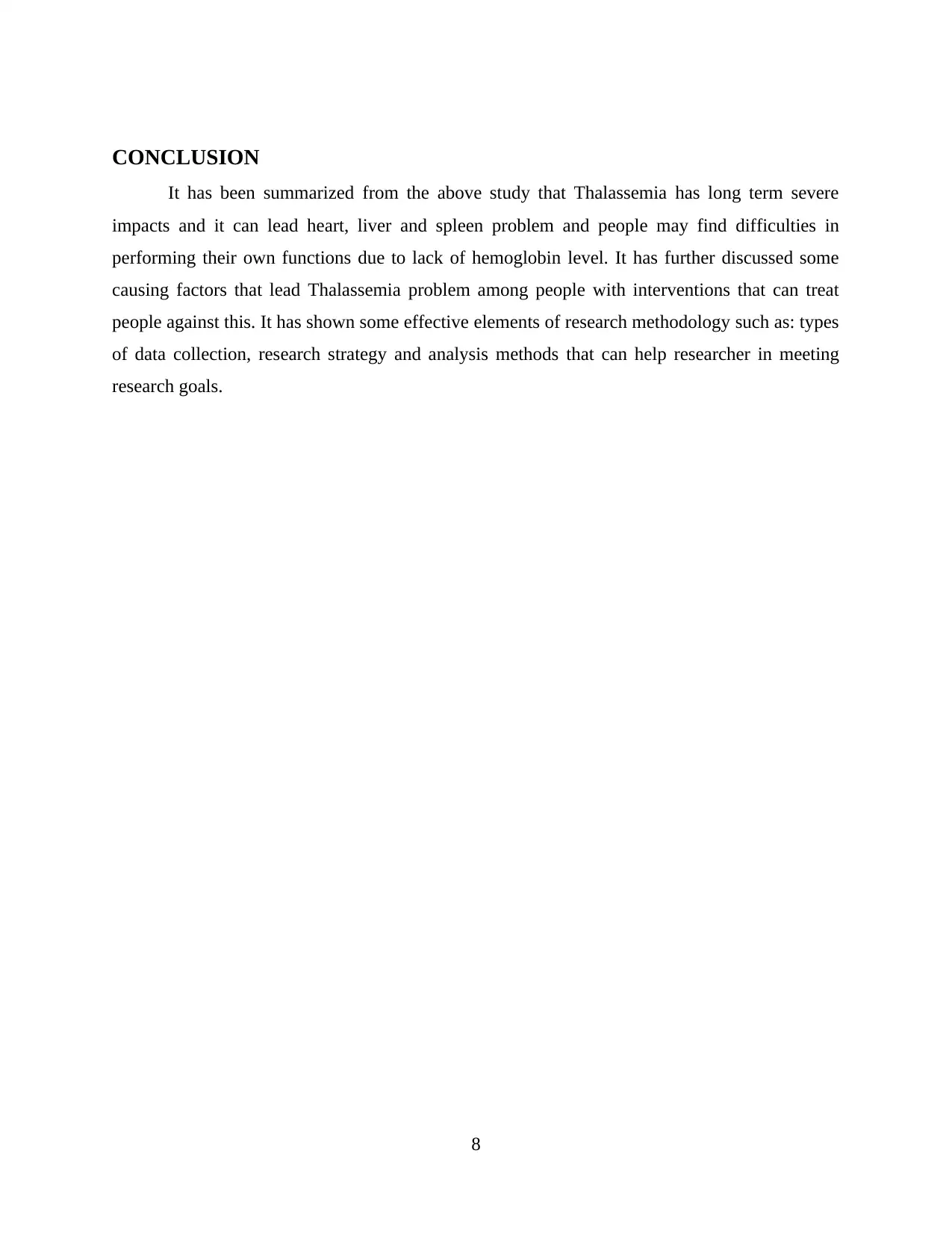
CONCLUSION
It has been summarized from the above study that Thalassemia has long term severe
impacts and it can lead heart, liver and spleen problem and people may find difficulties in
performing their own functions due to lack of hemoglobin level. It has further discussed some
causing factors that lead Thalassemia problem among people with interventions that can treat
people against this. It has shown some effective elements of research methodology such as: types
of data collection, research strategy and analysis methods that can help researcher in meeting
research goals.
8
It has been summarized from the above study that Thalassemia has long term severe
impacts and it can lead heart, liver and spleen problem and people may find difficulties in
performing their own functions due to lack of hemoglobin level. It has further discussed some
causing factors that lead Thalassemia problem among people with interventions that can treat
people against this. It has shown some effective elements of research methodology such as: types
of data collection, research strategy and analysis methods that can help researcher in meeting
research goals.
8
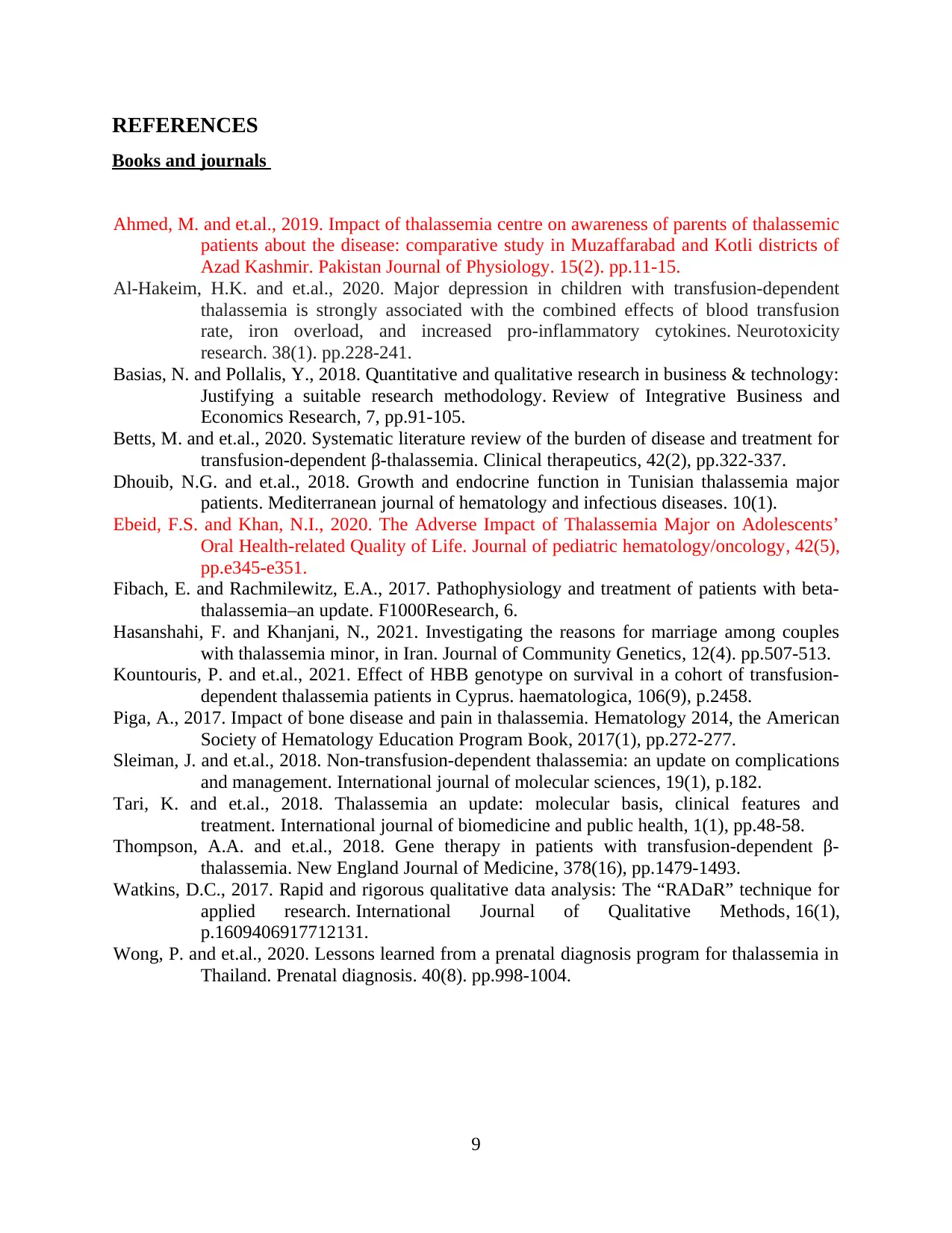
REFERENCES
Books and journals
Ahmed, M. and et.al., 2019. Impact of thalassemia centre on awareness of parents of thalassemic
patients about the disease: comparative study in Muzaffarabad and Kotli districts of
Azad Kashmir. Pakistan Journal of Physiology. 15(2). pp.11-15.
Al-Hakeim, H.K. and et.al., 2020. Major depression in children with transfusion-dependent
thalassemia is strongly associated with the combined effects of blood transfusion
rate, iron overload, and increased pro-inflammatory cytokines. Neurotoxicity
research. 38(1). pp.228-241.
Basias, N. and Pollalis, Y., 2018. Quantitative and qualitative research in business & technology:
Justifying a suitable research methodology. Review of Integrative Business and
Economics Research, 7, pp.91-105.
Betts, M. and et.al., 2020. Systematic literature review of the burden of disease and treatment for
transfusion-dependent β-thalassemia. Clinical therapeutics, 42(2), pp.322-337.
Dhouib, N.G. and et.al., 2018. Growth and endocrine function in Tunisian thalassemia major
patients. Mediterranean journal of hematology and infectious diseases. 10(1).
Ebeid, F.S. and Khan, N.I., 2020. The Adverse Impact of Thalassemia Major on Adolescents’
Oral Health-related Quality of Life. Journal of pediatric hematology/oncology, 42(5),
pp.e345-e351.
Fibach, E. and Rachmilewitz, E.A., 2017. Pathophysiology and treatment of patients with beta-
thalassemia–an update. F1000Research, 6.
Hasanshahi, F. and Khanjani, N., 2021. Investigating the reasons for marriage among couples
with thalassemia minor, in Iran. Journal of Community Genetics, 12(4). pp.507-513.
Kountouris, P. and et.al., 2021. Effect of HBB genotype on survival in a cohort of transfusion-
dependent thalassemia patients in Cyprus. haematologica, 106(9), p.2458.
Piga, A., 2017. Impact of bone disease and pain in thalassemia. Hematology 2014, the American
Society of Hematology Education Program Book, 2017(1), pp.272-277.
Sleiman, J. and et.al., 2018. Non-transfusion-dependent thalassemia: an update on complications
and management. International journal of molecular sciences, 19(1), p.182.
Tari, K. and et.al., 2018. Thalassemia an update: molecular basis, clinical features and
treatment. International journal of biomedicine and public health, 1(1), pp.48-58.
Thompson, A.A. and et.al., 2018. Gene therapy in patients with transfusion-dependent β-
thalassemia. New England Journal of Medicine, 378(16), pp.1479-1493.
Watkins, D.C., 2017. Rapid and rigorous qualitative data analysis: The “RADaR” technique for
applied research. International Journal of Qualitative Methods, 16(1),
p.1609406917712131.
Wong, P. and et.al., 2020. Lessons learned from a prenatal diagnosis program for thalassemia in
Thailand. Prenatal diagnosis. 40(8). pp.998-1004.
9
Books and journals
Ahmed, M. and et.al., 2019. Impact of thalassemia centre on awareness of parents of thalassemic
patients about the disease: comparative study in Muzaffarabad and Kotli districts of
Azad Kashmir. Pakistan Journal of Physiology. 15(2). pp.11-15.
Al-Hakeim, H.K. and et.al., 2020. Major depression in children with transfusion-dependent
thalassemia is strongly associated with the combined effects of blood transfusion
rate, iron overload, and increased pro-inflammatory cytokines. Neurotoxicity
research. 38(1). pp.228-241.
Basias, N. and Pollalis, Y., 2018. Quantitative and qualitative research in business & technology:
Justifying a suitable research methodology. Review of Integrative Business and
Economics Research, 7, pp.91-105.
Betts, M. and et.al., 2020. Systematic literature review of the burden of disease and treatment for
transfusion-dependent β-thalassemia. Clinical therapeutics, 42(2), pp.322-337.
Dhouib, N.G. and et.al., 2018. Growth and endocrine function in Tunisian thalassemia major
patients. Mediterranean journal of hematology and infectious diseases. 10(1).
Ebeid, F.S. and Khan, N.I., 2020. The Adverse Impact of Thalassemia Major on Adolescents’
Oral Health-related Quality of Life. Journal of pediatric hematology/oncology, 42(5),
pp.e345-e351.
Fibach, E. and Rachmilewitz, E.A., 2017. Pathophysiology and treatment of patients with beta-
thalassemia–an update. F1000Research, 6.
Hasanshahi, F. and Khanjani, N., 2021. Investigating the reasons for marriage among couples
with thalassemia minor, in Iran. Journal of Community Genetics, 12(4). pp.507-513.
Kountouris, P. and et.al., 2021. Effect of HBB genotype on survival in a cohort of transfusion-
dependent thalassemia patients in Cyprus. haematologica, 106(9), p.2458.
Piga, A., 2017. Impact of bone disease and pain in thalassemia. Hematology 2014, the American
Society of Hematology Education Program Book, 2017(1), pp.272-277.
Sleiman, J. and et.al., 2018. Non-transfusion-dependent thalassemia: an update on complications
and management. International journal of molecular sciences, 19(1), p.182.
Tari, K. and et.al., 2018. Thalassemia an update: molecular basis, clinical features and
treatment. International journal of biomedicine and public health, 1(1), pp.48-58.
Thompson, A.A. and et.al., 2018. Gene therapy in patients with transfusion-dependent β-
thalassemia. New England Journal of Medicine, 378(16), pp.1479-1493.
Watkins, D.C., 2017. Rapid and rigorous qualitative data analysis: The “RADaR” technique for
applied research. International Journal of Qualitative Methods, 16(1),
p.1609406917712131.
Wong, P. and et.al., 2020. Lessons learned from a prenatal diagnosis program for thalassemia in
Thailand. Prenatal diagnosis. 40(8). pp.998-1004.
9
⊘ This is a preview!⊘
Do you want full access?
Subscribe today to unlock all pages.

Trusted by 1+ million students worldwide
1 out of 9
Related Documents
Your All-in-One AI-Powered Toolkit for Academic Success.
+13062052269
info@desklib.com
Available 24*7 on WhatsApp / Email
![[object Object]](/_next/static/media/star-bottom.7253800d.svg)
Unlock your academic potential
Copyright © 2020–2025 A2Z Services. All Rights Reserved. Developed and managed by ZUCOL.





